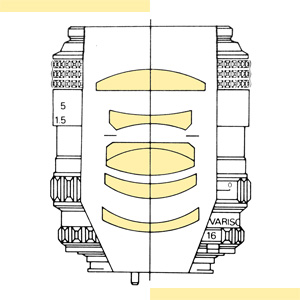Das Minolta MD 2.8/85 mm VariSoft wurde 1978 eingeführt. Es basiert auf einem hauseigenen Patent, das die Einführung kontrollierter sphärischer Aberrationen in ein ansonsten voll korrigiertes optisches System aufzeigt. Minolta hatte zuvor ein 1.7/85 mm im Angebot, dessen sphärische Restfehler bei f1.7 zu einer deutlich weicheren Wiedergabe bei vollem Detailreichtum geführt hatte - beliebt bei Portrait-Fotografen, aber in zeitgenössischen Tests als Fehler beanstandet. Minolta schuf daher als Nachfolger des 1.7/85 mm zwei Optiken, die sich von ihrer Charakteristik her grundlegend unterschieden: das superscharfe, kontrastreiche MD 2/85 mm sowie das hier gezeigte, bei Bedarf stark weich zeichnende MD 2.8/85 mm VariSoft.
 |
MINOLTA 85mm 1:2.8 VariSoft (6 Linsen / 5 Glieder)
Fassung: MD-II (1979), MD-III (1984) |
I may be interesting to know that Minolta - before releasing the MD 2/85mm VariSoft - had a few more prototypes for their upcoming soft focus lens:
1) the most simple was a Triplet with an additional negative lens behind the triplet for varying the softness
2) another was a Tessar type with an additional negative lens either in front of or behind the triplet for varying the softness
3) there was also a Triplet with two negative lenses (one in front, one behind), both moving independently
4) then there was a Heliar type with an addional negative lens at the end; here we had three groups moving (a. front dublet plus negative center lens of the Heliar; b. rear dublet of the Heliar, c. additional negative lens at the rear)
5) the version which was chosen for production is a Tessar type as well, with an additional positive and negative lens at the rear. Three groups are being moved: a. the Tessar (fron) group, b. the positive lens behind the Tessar, and c. the negative lens at the rear (see the lens section above).
Focusing is done by moving the Tessar front group.
Varying the degree of softness is done by varying the distance between the last (negative) lens and the other five lenses in front[/b]. By doing this, not only the spherical aberrations are (=softness) are changed, but also the focal length.
Thus, to keep the focusing invariable [while varying [the softness, the front focusing Tessar group must have a slight additional movement. All this results in a pretty complicated mechanical construction - and in an equally high price, of course.
Performance on 16 MP APS-C (reproduced with permission from Benjamin Gövert / vintagelensreviews.com):
The MD Varisoft Rokkor 85 mm f/2.8 is a rare specialized lens which was designed as a portraiture-friendly companion of the extremely sharp MD 85 mm f/2.0. The Varisoft features eight aperture blades and a three-stage mechanism which introduces spherical aberrations into the picture. This results in a loss of sharpness and – depending on the setting and aperture – a mild to extreme haze/glow which reduces contrast. Used prices for this lens are quite high today because of it’s rareness.
Regular: At f/2.8, the lens shows a minimal haze and medium sharpness with consistent performance across the frame. f/4 shows no signs of haze anymore, but sharpness doesn’t improve much. That changes at f/5.6 where the center reaches a good rating but the corners stay behind. Sharpness further improves at f/8, reaching close to very good levels in the center. Stopping down to f/11 doesn’t affect central sharpness but finally brings the corners to the same level. Diffraction slightly softens the image at f/16.
Varisoft mode: As described before, the “SOFT” function introduces colorless spherical aberrations into the image in three levels (+1 to +3), resulting in a subtle to extreme haze or glow and softness “dreamyfying” the picture. It also slightly shortens the focal length by 7.8% to about 78 mm at the highest setting. The SOFT function was designed as a creative tool and can for example be used to give portraits a very special look.
Looking at the Minolta’s charts, it becomes clear that the SOFT effect can be well controlled at f/5.6. SOFT +1 introduces a very slight haze that only softens contrasty edges. Increasing to +2 and +3 subjectively really doubles and triples the impact of the aberrations, giving you plenty of range to decide whether the image should be tack sharp or nicely soft.
That is not the case at f/2.8. Setting SOFT to +1 is enough to turn the test chart into a blurry and foggy mess. Since the first setting hits the image that hard, increasing to +2 and +3 doesn’t give you the impression of tripling the effect although that actually seems to be the case. On +3, there is very little contrast left in the picture and the glow from bright areas reaches anywhere.
In Conclusion, the 85 mm f/2.8 Varisoft does not impress as a short tele. It’s neither outstandingly sharp nor does it offer especially fast f-stops. It is well corrected concerning CAs, vignetting and distortion, but that’s about it – if there wouldn’t be this second control ring with the “SOFT” inscription. This lens was designed for dreamy pictures. That’s where it shines, where very few modern lenses can compete and that’s how it should be used. And if you happen to long for a regular 85 mm while shooting, the Varisoft sure is good enough to serve as one when needed.

